The elderly are at increased risk of aspiration for many reasons and this can lead to pneumonia. Aspiration pneumonia accounts for over 80% of pneumonia cases in older adults (1).
Let’s explore aspiration and why prevention for geriatric patients is so important.
What is Aspiration?
Aspiration occurs when food or liquids go from the mouth or upper gastrointestinal tract into the lungs through the larynx (2).
Bacteria, nasal secretions, saliva, foreign objects, food, fluids, and/or stomach contents end up in the lungs.
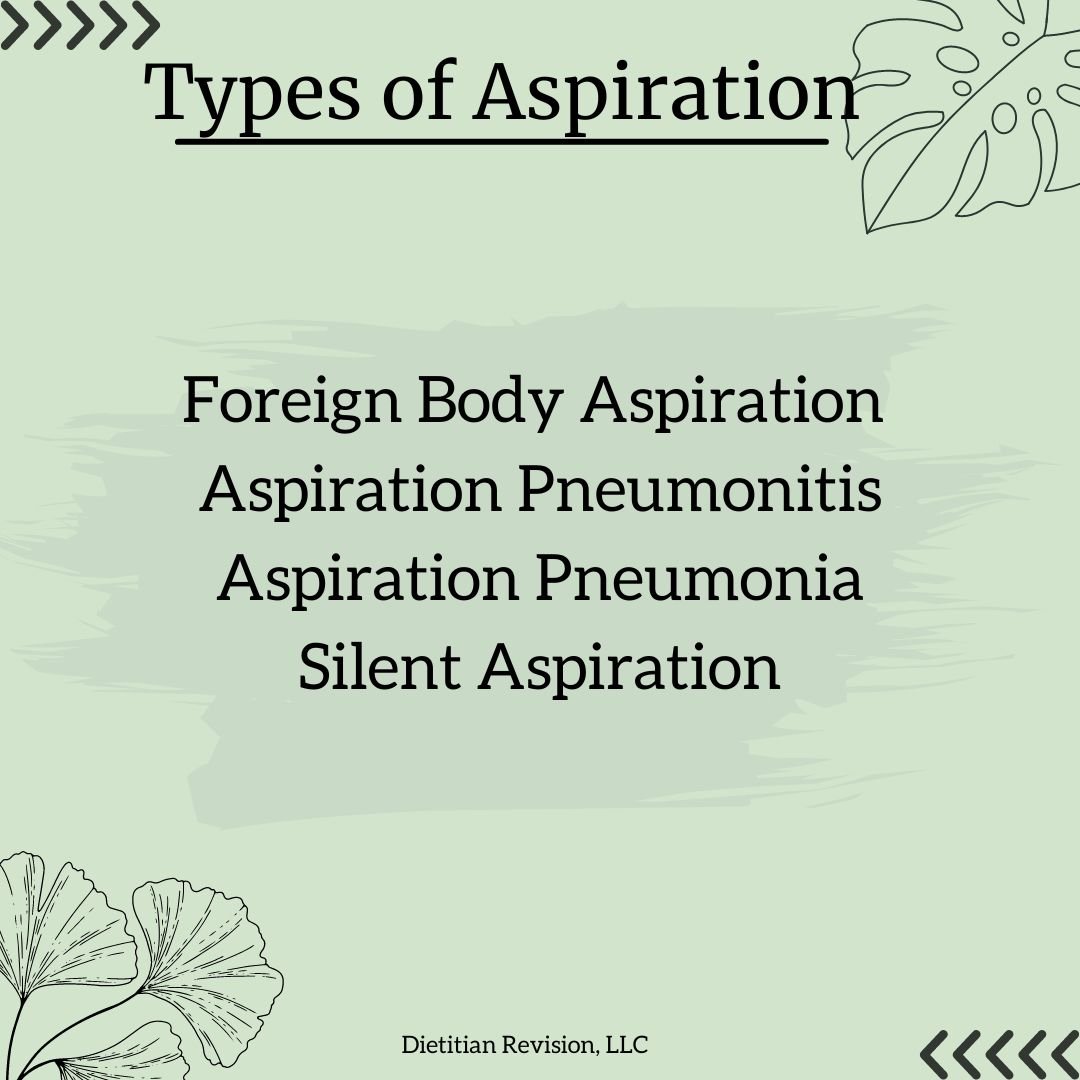
Foreign Body Aspiration
Foreign body aspiration occurs when an object blocks the airway causing inability to breathe.
This is the least common type of aspiration, however can be fatal if the object is not able to be cleared (3).
The Heimlich maneuver is what typically treats this type of aspiration. Learn more about how to prevent choking in the elderly.
Aspiration Pneumonitis
Aspiration pneumonitis happens when reflux of stomach contents occurs and goes into the lungs.
The acidic fluid in the stomach and food particles end up in the lungs and cause inflammation and infection.
Aspiration Pneumonia
Aspiration pneumonia can occur when foods and/or beverages go into the lungs during swallowing, instead of down the throat.
These substances then grow bacteria in the lungs, along with possible bacteria from the mouth. This leads to infection in the lungs.
Silent Aspiration
When food or fluids go into the lungs, a cough response is protectively triggered. For some this reflex is impaired and there is no reaction (atussia).
This increases the likelihood of aspiration occurring, since there is not a protective cough to prevent this material and bacteria from entering the lungs.
When no cough or other signs occur, this is called “silent aspiration.”
The elderly are at increased risk of silent aspiration since the urge to cough and ability to clear the lungs reduces with age (4).
Signs & Symptoms
Symptoms of aspiration may vary depending on which type occurs, what is aspirated, and how much.
Some signs that aspiration has occurred and/or aspiration pneumonia is developing include (5), (6):
- Coughing
- Choking
- Shortness of breath (SOB)
- Hypoxemia: low blood oxygen levels
- Hypoxia: low tissue levels of oxygen
- Cyanosis: bluish skin discoloration due to low oxygen
- Fever
- Tachycardia: fast heart rate
- Abnormal chest x-ray
- Acute lung infection
- Pneumonia
- Respiratory failure
- Speaking difficulty
- Voice hoarseness
- Leukocytosis: elevated white blood cells
- Headache
- Nausea and vomiting

Who’s at Risk?
Many factors can put older adults at risk for aspiration. Some of these risk factors include (7) (8) (9) (10) (11) (12) (13):
- Chronic cough
- Asthma
- Dysphagia: swallowing difficulty
- Pneumonia
- Use of sedatives
- Dementia
- Alcohol use
- Traumatic brain injury (TBI)
- Stroke
- Seizures
- Encephalopathy: disease impacting the brain causing altered mental status
- Gastroesophageal reflux (GERD)
- Gastroparesis: impaired mobility of the stomach
- Bowel obstruction: intestinal blockage
- Achalasia: impaired movement of the esophagus impacting ability to swallow
- Esophageal stricture: tightening or narrowing of the esophagus
- Intubation
- Tube feeding
- Chronic obstructive pulmonary disease (COPD)
- Parkinson’s disease
- Sleep apnea
- Cardiopulmonary resuscitation (CPR)/cardiac arrest
- Anesthesia
- ICU patients
- Multiple sclerosis (MS)
- Sedation
- Tracheostomy
- Head and neck cancer, especially with chemo or radiation
- Gastrectomy: surgical removal of the stomach
- Malnutrition
- Use of antipsychotics
- Polypharmacy: use of multiple medications
- Periodontal disease
While these risk factors increase the chances of aspiration, some people are actually at a lower risk of actually developing aspiration pneumonia.
People receiving excellent oral care are at lower risk for aspiration pneumonia (13). This decreases bacteria in the mouth so even if aspiration occurs it is less likely to cause pneumonia.
The opposite is also true. Those with poor oral care, have a greater chance of aspiration developing into pneumonia.
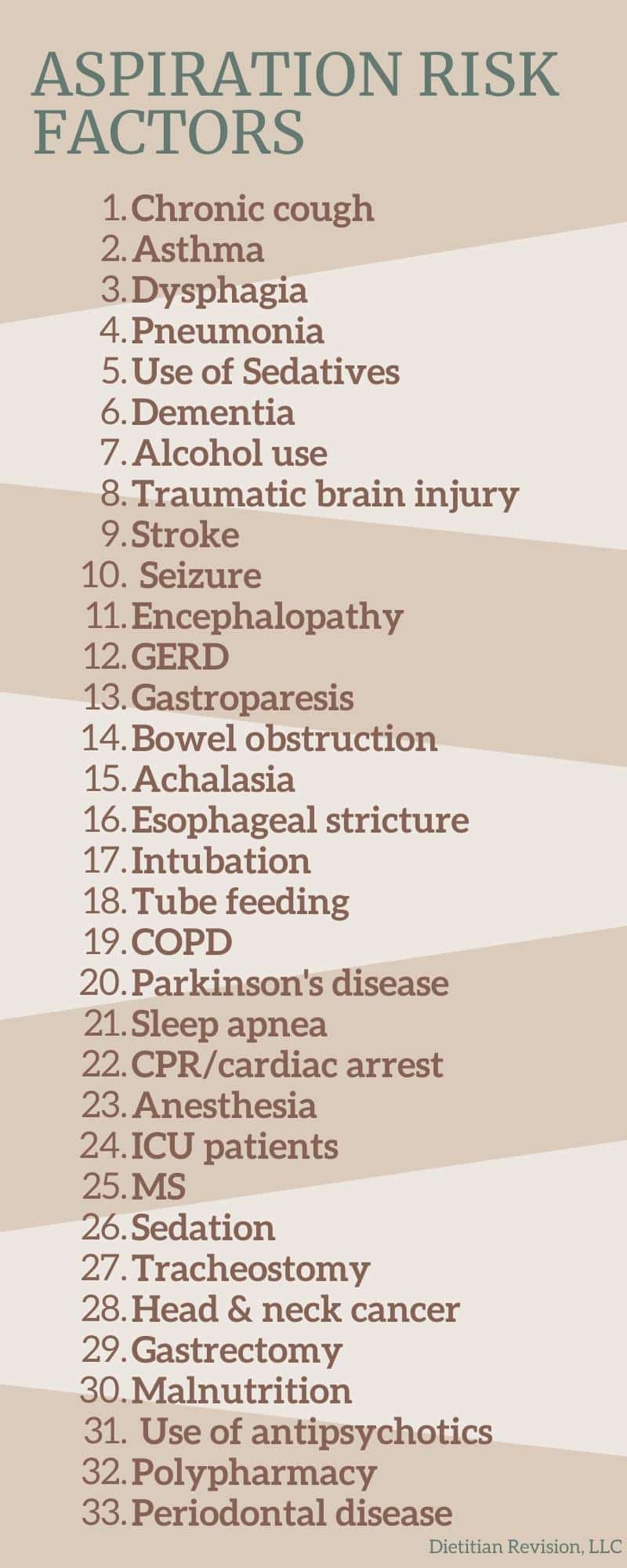
Aspiration Complications
Aspiration and associated pneumonia can cause a variety of complications in the elderly, including (14), (15)
- Lung tissue injury
- Increased hospitalization
- Hypoxemia: low blood oxygen levels
- Respiratory failure
- Long term lung inflammation
- Lung abscess: pus filled, inflamed lung tissue
Prevention of Aspiration
Aspiration and its associated pneumonia can be debilitating to the geriatric population. Here are some ways to prevent aspiration (16).
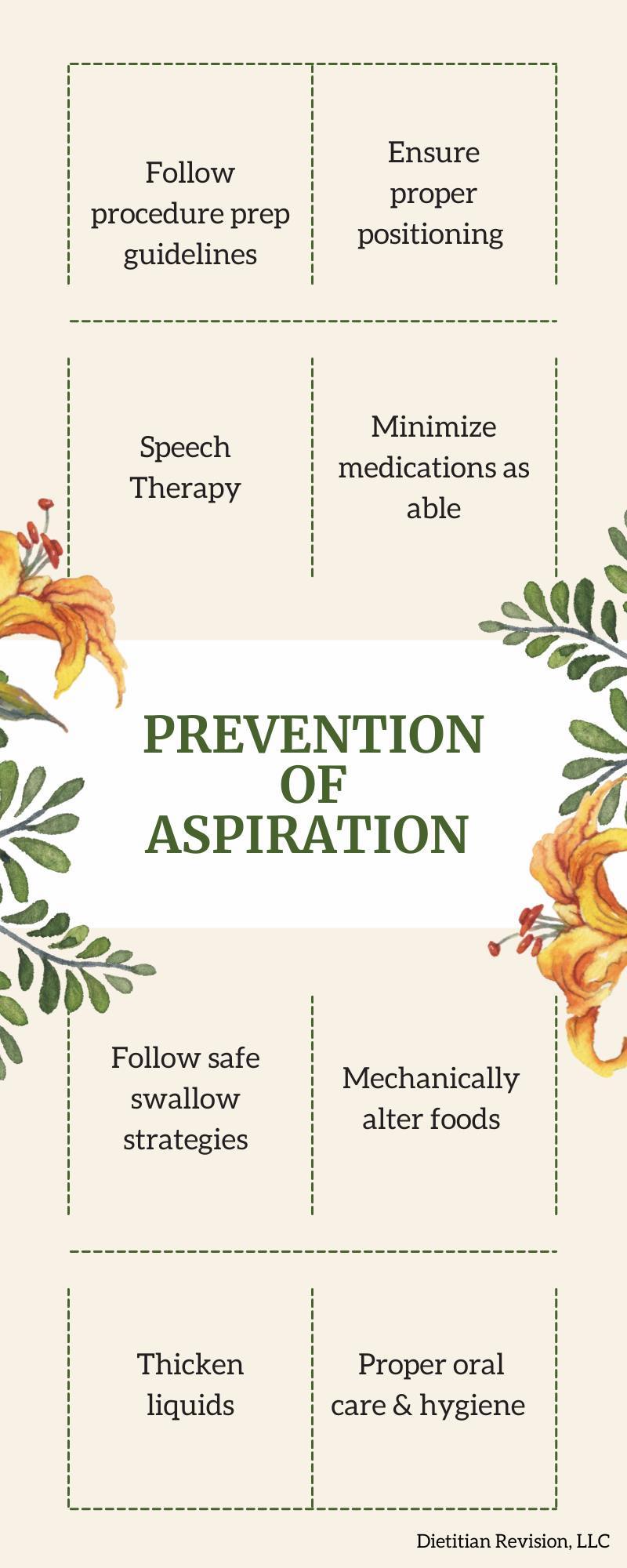
Procedure Preparation
Following physician guidance for not eating and drinking prior to surgical procedures can reduce risk of aspiration during anesthesia.
Medications
Some medications increase the risk for aspiration (17):
- Antipsychotics
- Sedatives
- Antihistamines
Routinely review medications with healthcare providers to ensure necessity and that benefits outweigh risks.
Positioning
Ensure proper positioning during eating and drinking for optimal safe swallow. Eat and drink upright, ideally in a chair sitting at a table.
If eating or drinking in bed, sitting upright is essential. For those receiving tube feedings, the head of the bed should be elevated during, as well as before and after feedings.
Speech Therapy
If signs of dysphagia are present, treatment from a speech language pathologist (SLP) can help prevent aspiration.
Speech therapy can help strengthen the muscles used in the swallow. This makes swallowing food and fluids safer and more functional.
They can also properly prescribe altered diets and swallowing strategies to minimize the risk of aspiration.
Safe Swallow Strategies
People with dysphagia may need to follow safe swallow strategies prescribed by a speech language pathologist (SLP).
Common safe swallowing strategies include:
- Tucking chin down during swallow
- Small bites and sips
- Swallowing multiple times after bites or sips
- Coughing or throat clearing after swallowing
- Alternating taking a bite of food with taking a sip of liquid
- Avoid talking while eating
- Sitting upright during meals and 30 minutes after
Mechanically Altered Diets
Mechanically altered diets are commonly prescribed when swallowing difficulty is present.
Ground and/or pureed foods are easier to chew and swallow, which helps prevent aspiration.
Learn more about altered diets at Dysphagia Diets and IDDSI Explained.
Thickened Liquids
Liquids can be especially difficult to move around the mouth and swallow. Thickening liquids can slow them down and make them easier to swallow.
Read Thickened Liquids to learn more.
Feeding Tubes
People being fed through feeding tubes in the stomach are also at risk for aspiration even if they do not eat anything by mouth.
Tube feeding formula can be reverse aspirated up from the stomach and into the lungs, similar to stomach contents.
Staying upright during tube feeding administration, and at least 30 minutes before and after, can help reduce the chance of aspiration. If in bed, the head of the bed should be elevated 30-45 degrees.
Some who have a history of aspiration with tube feeding may need a different type of feeding tube called a G-J tube, so food can be administered into the jejunum.
Tube feeding going directly down into the intestines, instead of the stomach, reduces the chance of aspiration.
Learn more about Feeding Tubes in the Elderly.
Oral Care
The cause of many elderly patient’s pneumonia is silent aspiration of oral bacteria (18). Keeping the mouth clean throughout the day and before bed can help prevent this.
Practical Takeaways
Dysphagia and aspiration are common occurrences in the elderly population. Proper oral hygiene can be the best defense to combat aspiration pneumonia.
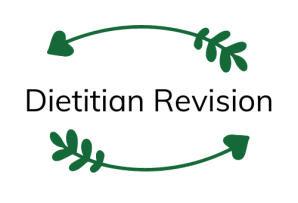


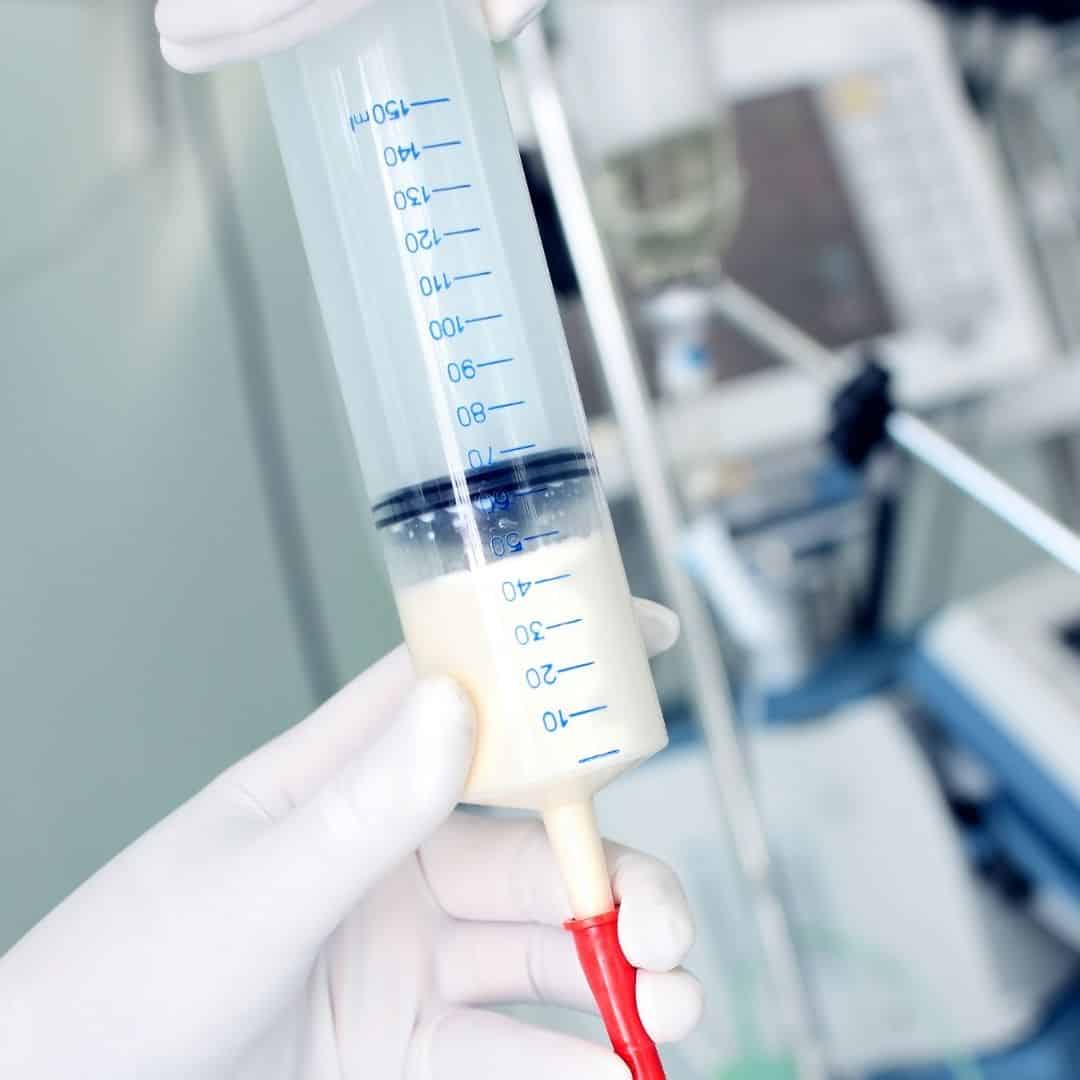
Really enjoyed the links to your previous articles! Such an important topic for all of us working with older adults. Thank you, Lori!
Kay